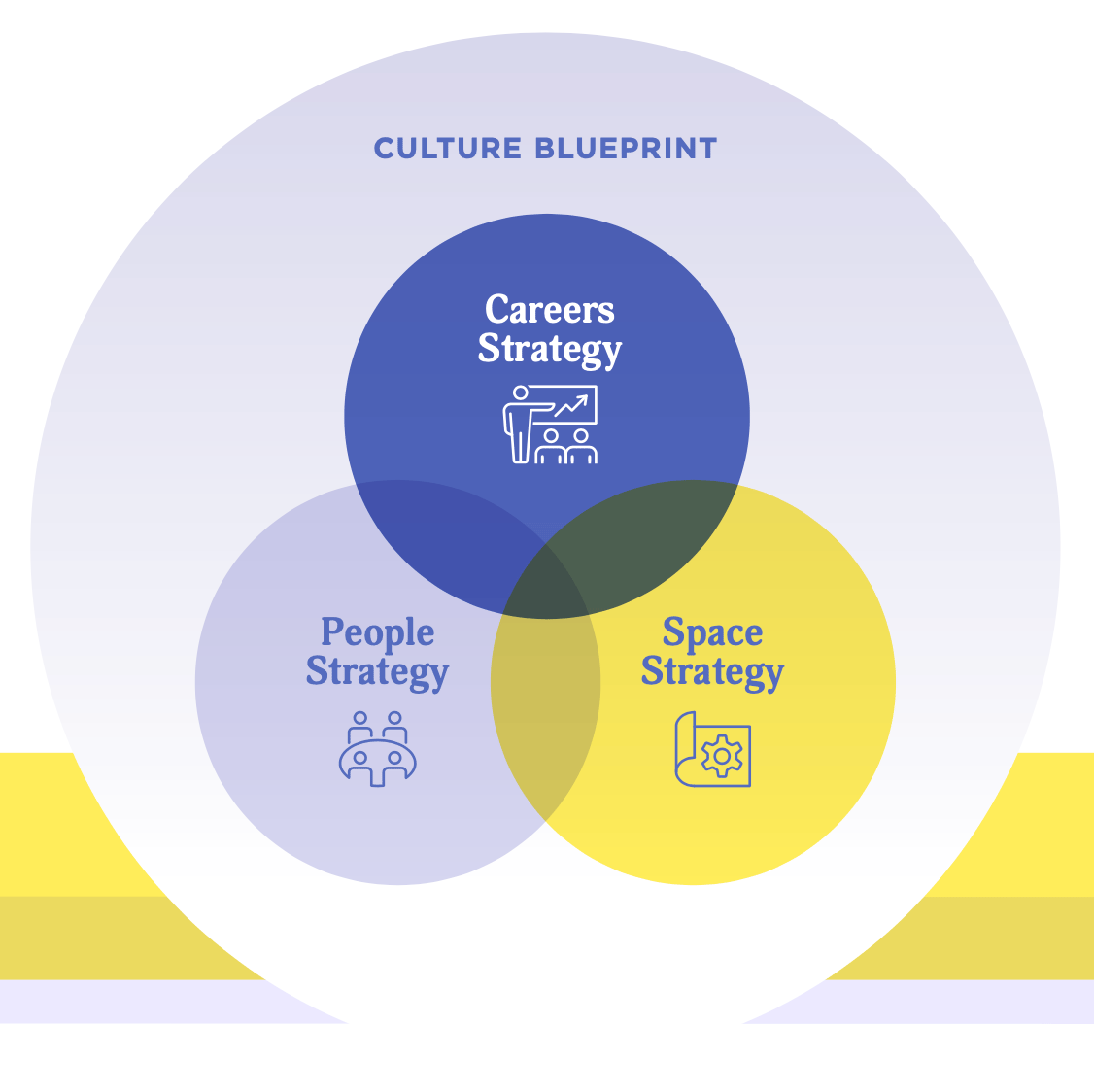How can leadership teams boost engagement and performance? Revitalize your culture with intentional careers, people, and space strategies.
By Emree Siaroff
A quick Google search on the words “company culture” returns about 48,300,000 results (in 0.75 seconds). While this has always been a hot topic, the Great Resignation, Great Retirement, and Canada’s labour shortages have seen more leaders than ever realize that the talent in their organizations is not just “an asset” but rather the fundamental element of their success.
In her Toronto Star op-ed, novelist, journalist, and editor Mireille Silcoff notes that after all we’ve been through during the pandemic, “boredom, lassitude, angst—signs of grief—are creeping into unexpected places. Waiting for a bus, you might suddenly wonder what any of it is for.” If these thoughts and feelings are being experienced in unexpected places (like at a bus stop), they are also going to be found in those places where they are expected, like work.
Your culture is the reason why people join, stay, and thrive in your organization. Culture is a combination of written and unwritten rules, norms, beliefs, behaviours, and values. It is how work gets done, how people interact with each other, and how they see their organization’s place in the world.
The success of an organization rests on whether its people are doing work that engages them in an environment that they want to be in. This type of work and environment also provides an antidote to today’s dominant feelings of malaise and discontent.
What is your unique organizational culture?
Think of an organization’s culture as its personality, but on a broader scale. Just like an individual’s personality, an organization shouldn’t try to be something it isn’t—it won’t be authentic, and leadership and staff will sense this. So long as the culture isn’t toxic or unsafe, it’s unwise to try to make wholesale changes overnight. Every personality has strengths and flaws, and perfection is never possible.
If you’re not sure what your organizational culture is, imagine a conversation over a family dinner. Around the dinner table, Aunt Jenny asks your employee, “So what is it like working at Company XYZ?” How your employee answers this question is, in essence, your organization’s culture. If they say, “I feel like I’m making a difference” or “the leaders are great, they really appreciate me” or “the whole team is awesome,” this means your employee has found a great place in your organization.
If your employee struggles to answer Aunt Jenny or doesn’t have a positive answer, it’s time to better understand your culture—and how you can impact it. It’s time to map out your Culture Blueprint.
What is a Culture Blueprint?
A Culture Blueprint is a framework designed for leaders to capture all that you know, need to know, are doing, and want to be doing to ensure your workforce continues to be part of your competitive advantage.
The term “culture” is often used as a catch-all for any number of issues, topics, and business planning activities. The Culture Blueprint that we’ve created has three overlapping pillars careers, people, and space—that together create the foundation and environment for all other organizational activities.
Mapping your Culture Blueprint with intention and honesty allows you to critically examine if your organization is on the right track with a solid foundation, if it needs repair and adjustment, or if it requires a massive overhaul to remain viable. Because culture is a set of rules, norms, beliefs, behaviours, and values, engaging emotion and storytelling is an effective way to start your mapping work.
Let’s get into it.

How do you start mapping your organization’s Culture Blueprint?
Here’s what you need to do. Gather your senior leadership team and slow things down. Provide time and space to step back from the pressures of daily management, creating an opportunity for you and your team to consider the culture of the organization you are leading together—and what is it likely to become tomorrow.
Here are a few future-focused questions to get you started and engage your leaders in a different type of conversation.
- Setting aside mission statements on the wall and core values presented in slides during employee orientation sessions, how would our staff speak about our culture at their family dinners? How sure are we of this answer? Do we, as the leadership team, agree?
- If we keep the same culture we currently have, what are 3-5 scenarios that might unfold in the future as a result of our culture? For example, who will be leading the company in ten years? What happens to people’s career advancement? How are the organization’s goals and metrics met or missed as a result of the intersection of culture and workforce potential?
- Which of the scenarios we’ve identified are worth exploring in more detail—either as a cautionary tale or to reinforce what is strong and noteworthy about our culture?
These types of questions help frame your Culture Blueprint. With new scenarios in mind, the next series of questions delves into the three pillars (careers, people, and space) that link culture to strategy and execution.
Organizations with healthy cultures explicitly align the lifelong career supports that are provided to employees, the priorities and management of their people, and space and physical environment considerations. With intentional planning, it becomes easier to look for opportunities in the overlaps between your careers, people, and space strategies.
The second step is to go deeper and ask questions like:
- What does our people strategy look like? How do our communication, onboarding, approach to DEI (Diversity, Equity, and Inclusion), and other key components play out in our organization?
- Do we have a careers strategy? Can people learn and grow? How do we handle change? What is the capacity of our leaders and managers?
- A space strategy is not only about physical space, although it is one component of it. How are we approaching hybrid work? The freelance or gig economy? Are we basing decisions on outdated workplace thinking?
What is this all for?
Many of us have experienced a massive societal reset in how we understand, connect with, and contribute to the world around us. During the pandemic, organizations with strong cultures that maintained honest communication with staff didn’t experience the same level of employee retention and engagement challenges as other organizations did.
The best strategy for success is taking the time to ask the right questions and, more importantly, to act on the answers—even if you don’t like them. Using Challenge Factory’s Culture Blueprint gives you a powerful, living tool that combines data and creativity to tease out the unique opportunities and potential of your organization.
No one wants a life of “boredom, lassitude, and angst.” Be the organization where your employees can tell Aunt Jenny that they are “excited, alive, and content.”
